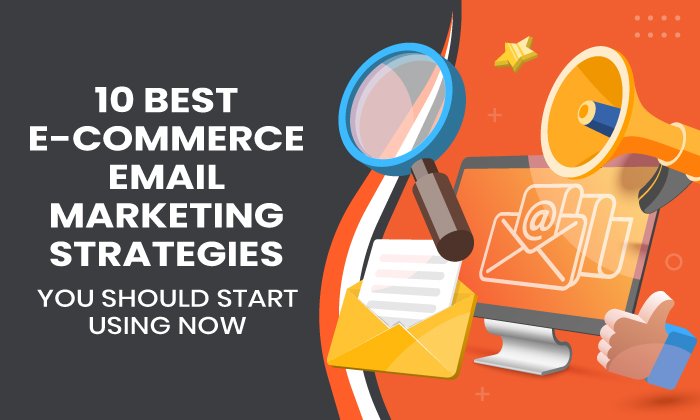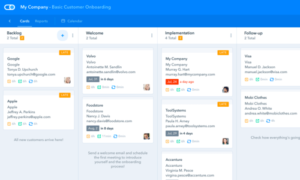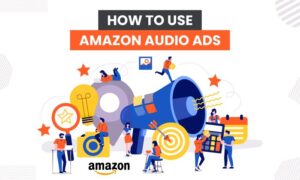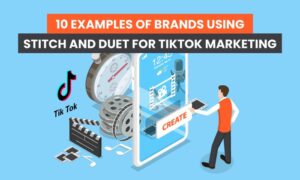There are plenty of e-commerce marketing channels available to grow your business, such as social media, PPC, SEO, and network marketing.
Successful e-commerce business owners, though, know that email marketing is one of the most profitable channels available.
Let’s take a look at “what is e-commerce email marketing?” and why e-commerce businesses should use it.
Finally, we’ll delve into the 10 best e-commerce email marketing strategies that you can implement immediately for great results.
What Is E-Commerce Email Marketing?
E-commerce email marketing is a marketing channel that enables you to send marketing messages to current and potential customers.
The strategies you use can be simple, like sending a weekly email blast with featured products, or complex—with multiple automated email series for cart abandonment, customer re-engagement, and exclusive membership deals.
Either way, the ultimate goal is to increase customer engagement and drive conversions.
Why Should E-Commerce Businesses Do Email Marketing?
As an e-commerce business owner, you’ve probably heard the sales pitch for just about every marketing channel there is.
You may even dabble in email marketing currently, but perhaps you don’t understand just how valuable a tool it is to your sales strategy.
Email marketing is a unique process in that, unlike social media or SEO, you own every piece of the funnel. Most importantly, you own the email subscriber list.
Why is that so important? With 4 billion daily email users (which will climb to 4.6 billion by 2025), you can’t afford to miss this incredible opportunity.
Through email marketing strategies, an e-commerce business can benefit from brand awareness, customer engagement, and high-intent customers. We also can’t ignore the conversion rate boosts that e-commerce businesses see when they implement a solid email marketing strategy, with the best ROI when compared to other marketing channels.
With an average of $36 earned for every $1 spent, that’s a whopping 3,600 percent ROI!
How to Do Email Marketing
While much of this article will focus on email marketing strategies for active marketers, we understand that not every e-commerce business is yet set up for email marketing.
If that’s you and you are completely brand new to email marketing, here are the steps you should take first:
- Set realistic and sustainable goals to grow your business, such as building an email list or improving customer retention by X percent.
- Select an email marketing software like MailChimp or Constant Contact.
- Map out your initial campaigns (e.g., welcome series, abandoned cart series, or new product launches.)
- Decide how you’ll collect email addresses. Many e-commerce companies offer a small coupon in exchange for email addresses.
- Set up landing pages as needed for campaigns.
- Set up campaign tracking with your chosen analytics provider.
Take the time to establish a firm foundation and you’ll be off to a better start than even many seasoned e-commerce businesses.
Best E-Commerce Email Marketing Strategies
Whether you’re new to email marketing or you’re looking to optimize your current setup, our best e-commerce email marketing strategies will provide you with a solid foundation to build your email marketing empire.
1. Start With a Welcome Series
For the best impression with new subscribers, establish a welcome email series. This gives you a chance to share your brand story, highlight your best products, and even offer a discount to drive sales.
Beyond that, a welcome series drives serious engagement. With an average open rate of 68.59 percent and an average click-through rate of 16.05 percent, a welcome series is a great part of your larger email marketing campaign.
Why?
First and foremost, a welcome series implies more than one email. Two or three emails is the sweet spot and anything beyond that is considered “spammy” and may scare off new subscribers.
With two emails, you have the chance to welcome the customer and invite them to connect. With three emails, you have the chance to do the previous two while also getting to know the customer more personally.
Take, for example, the NewEgg welcome series below which welcomes the customer and then invites them to connect with the mobile app:
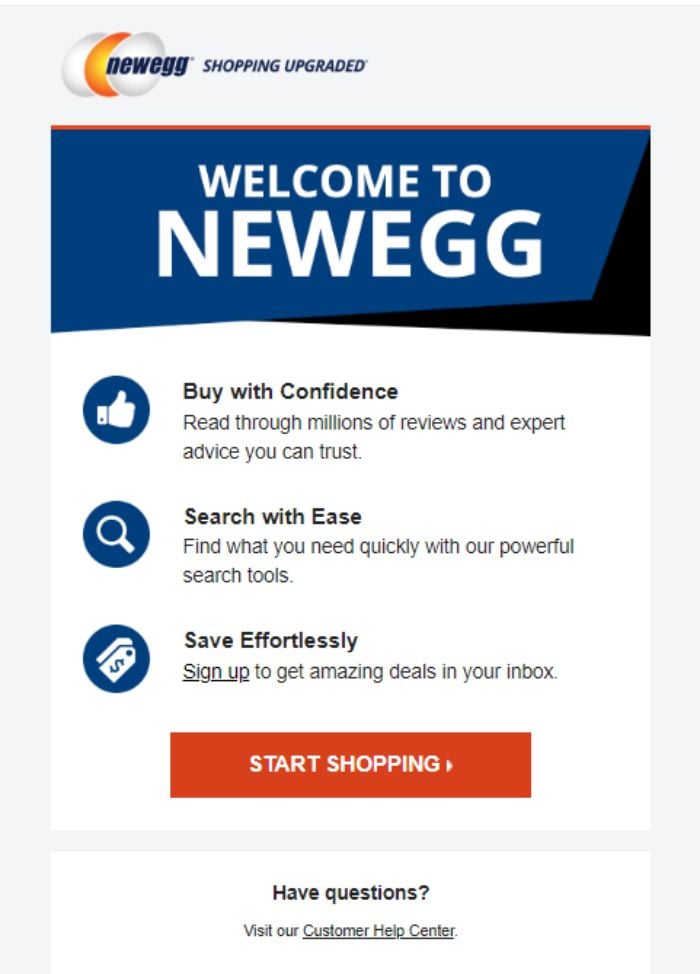
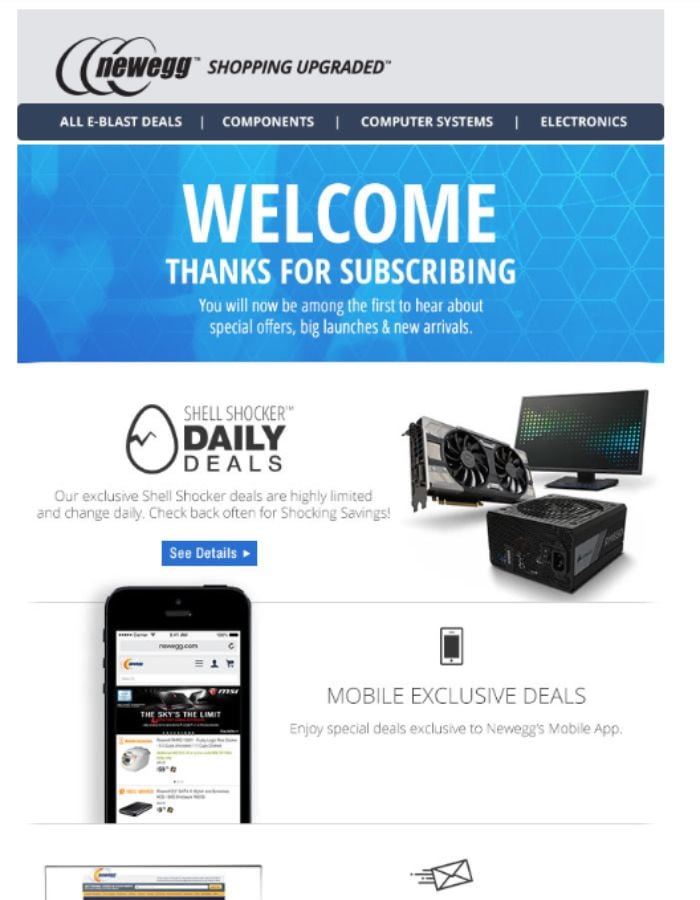
Whether you choose two or three emails, you want to be sure to include a few key elements in each email.
The initial welcome email should:
- thank the subscriber
- welcome them to the brand
- let them know what to look forward to in future emails
If you made a promise upon sign-up, like a discount, that needs to be included as well.
The second welcome email should then:
- give subscribers a further way to connect through mobile apps or social media
- focus on the value you or your products can provide to their lives
- tell them why they should purchase
2. Be Sure to Include a Clear Call to Action
What do you want your subscribers to do?
Whether that’s reading your latest blog post, watching a promotional video, or buying your newest product, your customers should know exactly what you want.
A call to action, or CTA, is a prompt given to users in a newsletter, on a website, or in a video. The prompt is usually a button or hyperlink that will help the user to achieve the goal.
According to Unbounce, including just one clear CTA in emails boosts clicks by 371 percent and sales by 1617 percent.
When it comes to effective CTAs, clear and concise is the way to go.
Create a compelling call-to-action for your email marketing campaigns by:
- Knowing the end goal.
- Using action-oriented words.
- Addressing your audience in the first person.
- Keeping your messaging short and snappy.
- Adopting a conversational tone.
You should also A/B test your calls to action regularly.
This means testing variations of your most used calls to action to see what elements your users respond to best. This includes verbs, button shape and color, length, and word order.
Unbounce saw an increase of 90 percent in their click-through rate just by changing “Start your free 30-day trial” to “Start my free 30-day trial.”
3. Use Personalization to Segment Your List
When is the last time you received an email that was specifically tailored to you?
If you’re like most people, that email had a greater chance of compelling you to act.
In fact, personalized promotional emails lift transaction rates and revenue six times higher than non-personalized emails.
Personalized marketing has three categories: contextual, demographic, and behavioral.
- Contextual personalization utilizes where a customer is in their journey. For example, just beginning to research the topic or being ready to make a buying decision.
- Demographic personalization utilizes demographic information such as age, gender, location, and household income level to inform recommendations.
- Behavioral personalization is the use of past purchases or website behavior (e.g., abandoned carts). Consider this email from Etsy that advertises products based on past purchases:
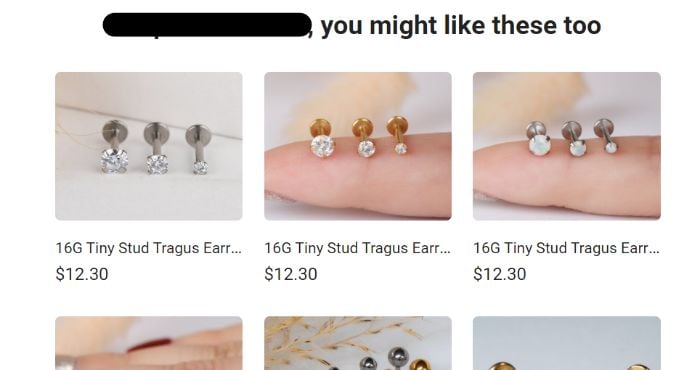
Depending on the size of your email list, you can even combine these categories to create intersections. Try combining past purchases with new location-based recommendations.
As your segmentation becomes more specific, the marketing campaigns will become more personalized and, more likely than not, successful.
4. Automate What You Can
Campaign Monitor found that automated emails create 320 percent more revenue than non-automated emails.
Therefore, automated email campaigns can be an invaluable tool in your overall marketing strategy.
From welcome series to cart abandonment to transactional emails to re-engagement campaigns, automated emails for e-commerce can level up your email marketing strategy.
Any email marketing software worth its weight will publish advice to help you automate your emails.
Klaviyo, for example, has various blog posts on topics such as automation flows to consider. It also has an automation user guide so you can set up your flows successfully.
5. Create a Dynamic Cart Abandonment Series
A cart abandonment series can be one of your most profitable series.
With an average open rate of 41.18 percent and a click rate of 9.50 percent, abandonment emails have a great opportunity for conversion.
When creating one, consider:
- The number of emails in the series: Three or four emails typically work best.
- The frequency of and intervals between each email: Try sending one email an hour after the cart abandonment, another the day after, and your final one three days later.
- Discounts to offer: If you want to secure a sale, try offering a discount code on the products they have in their cart.
- Subject lines: Subject lines strongly influence the CTR of your cart abandonment series, and can make sure your audience opens their email and reads the information you’re providing.
- Calls to action: Your CTA needs to convince your prospective customers to return to their carts.
Additionally, your cart abandonment series can be a great place to personalize. The obvious one here is to include the products left behind in the cart like Chewy does below:
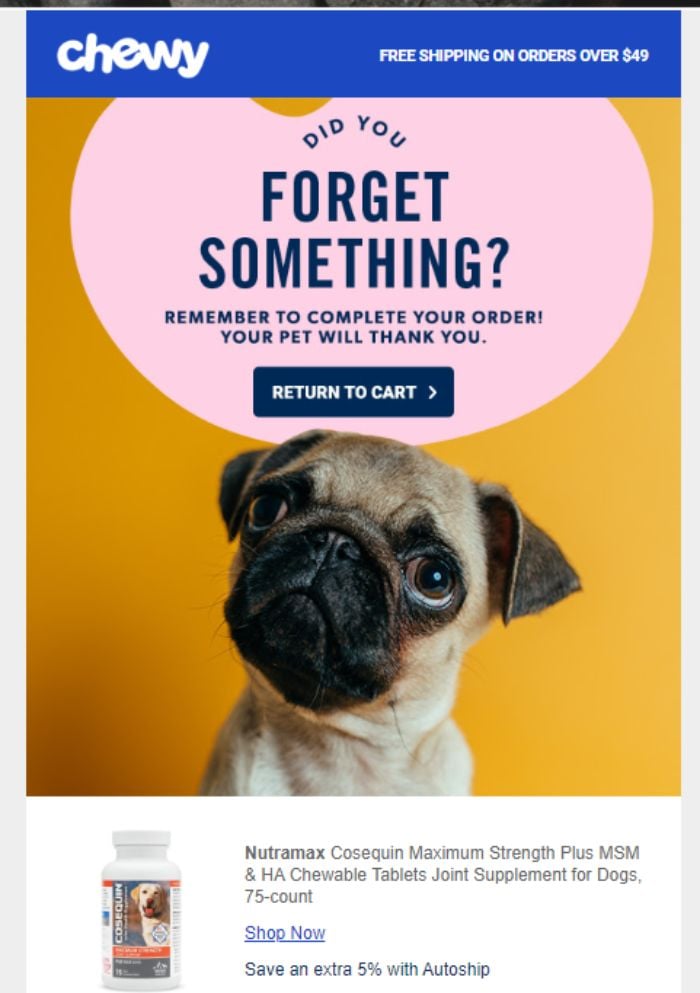
6. Perform Split Testing
How do you know whether your email campaigns are as effective as possible?
Without split testing, you don’t!
Split testing (sometimes called A/B testing) is a marketing strategy that pits two or more similar variations of an element against one another.
For example, a split test may test the efficiency of two CTA buttons, one black with white text and one white with black text.
The goal is to find the best variations of common email elements to ensure that your emails have the greatest return on investment—such as testing user experience design elements.
This can result in better conversion rates of up to 400 percent.
Try to test:
- subject lines
- preview text
- product imagery
- layout
- image size
- font size
- font color
- button color
- send day and time
- copy
- pricing and discounts
- social media icons
When it comes to running successful split tests, there are some ground rules to follow:
- Stick with one variable at a time.
- Identify your goal.
- Know your “control” and your “challenger.”
- Split your groups equally and randomly.
- Decide significance parameters.
Once you have statistically significant (as determined by you) results in hand, it’s time to implement changes if necessary.
7. Use Email to Encourage Engagement
We’ve touched briefly on engagement in the welcome series section. However, engagement emails don’t need to be reserved only for welcome email campaigns.
Email newsletters offer a unique opportunity to capture your audience. This is especially true if open rates are high but click-through rates are lacking.
Segment your audience according to their engagement, and deliver appropriate messages accordingly.
Subscribers who have previously converted, for example, are 74.7 percent more likely to do so again.
Here, you would want to capitalize on brand trust. Ask yourself:
“Why did the customer buy from me before. Why should they do so again?”
This would be a good opportunity for a product recommendations email based on their previous purchase.
If it’s a consumable product, then a subscription offer email is easy enough. If it’s a non-consumable product, then a complementary product email is a safe bet.
For subscribers yet to convert, focus on building brand trust and offer discounts to make a purchase less risky.
8. Offer Exclusive Experiences and Rewards to Loyal Subscribers
Segmentation makes it easier to personalize emails and reward loyal customers.
By segmenting your email list by longtime subscribers or the greatest money spent, you can provide an exclusive experience that makes them feel valued by your brand.
Notice I say experience and reward as opposed to discount.
Can a discount be a reward? Absolutely. However, discounts do have a downside. In particular, they can cheapen your brand’s value, especially in the eyes of loyal customers.
A loyal customer knows the value of your product.
Instead of a discount offer, consider an experiential reward. This is also backed by millennial spending habits. After all, 78 percent of millennials would rather spend their money on an experience than a product.
- Give away once-in-a-lifetime trips.
- Offer meet and greet events with brand ambassadors.
- Make a brilliant rewards program.
- Design a top-tier social media group where you host virtual events.
9. Set Up Back In Stock or Wishlist Emails
We’ve touched on the importance of automated emails, and we’ve even covered two automated campaigns in particular:
- A welcome series.
- A cart abandonment series.
The next on our list to highlight is the back-in-stock (or “wishlist” emails.)
With recent constraints on the supply chain, more brands than ever have had item stocking and inventory troubles.
You can either waste an opportunity by removing temporarily unavailable items from your website, or you can capitalize on customer wants with back-in-stock emails.
As the name suggests, back-in-stock emails alert customers when a product they expressed interest in is back in stock and available to purchase.
Depending on your platform, a back-in-stock email option may be a product page feature or it may require additional configuration (and add-ons like an app).
However much effort it takes on your part, the return is worth it!
According to a study by Barilliance, back-in-stock emails had the highest open rate (65.32 percent) when compared to alternative post-purchase emails.
10. Utilize Dynamic Content
We already know that personalization drives conversions.
The same can be said for a subset of personalization known as dynamic content, which has been shown to increase email ROI by 100 percent!
So, what is dynamic content?
Dynamic content is personalized content generated based on user signals:
- Product recommendations based on past purchases or previously viewed products.
- Calls to action tailored to the user’s browsing behaviors.
- Free exclusive offers (such as ebooks and white papers) for someone in the “research” stage of the buyer’s journey.
With most major email marketing software companies, dynamic content will be an impressive addition to most e-commerce email templates.
E-Commerce Email Templates
Here are a few e-commerce email templates to help you build your e-commerce email marketing campaigns.
1. Welcome Email Template
This welcome email template combines clean lines combined with pops of color to be striking and eye-catching. When customizing it, make sure to use the large “featured image” space for a friendly brand image or a featured product lifestyle relevant to you.
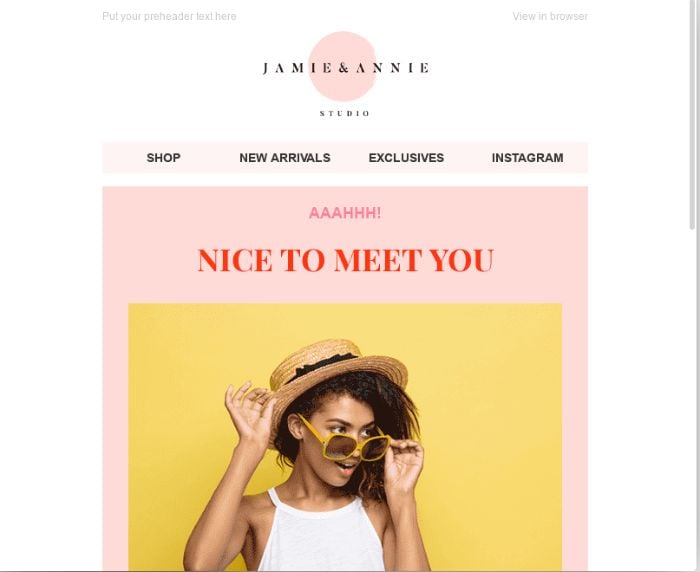
2. Abandoned Cart Email Template
The creative, clean design of this abandoned cart email template is great for any e-commerce site. Stylized text and a large product image make it easy to read, drawing attention to the humorous copy.
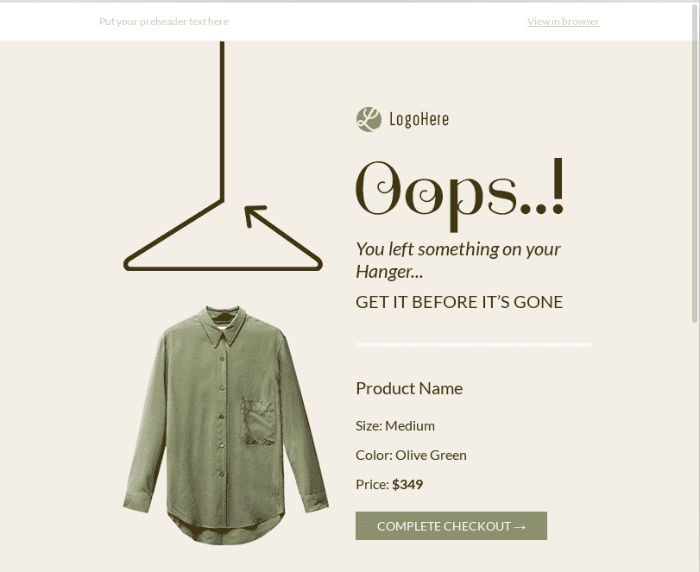
3. Discount Email Template
Make your big sales event known with this beautifully stylized email template. Featuring bold text and modules for product imagery, your customers will easily see the value in your offer.
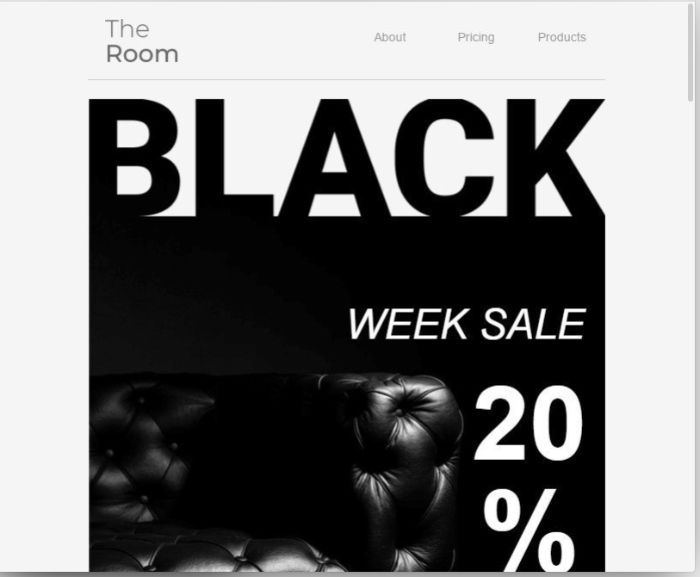
4. Product Recommendations Email Template
Let your product recommendations do the talking with this image-heavy recommendations email template. The faux navigation also adds a standout touch that makes your readers feel as if they’re shopping your website.
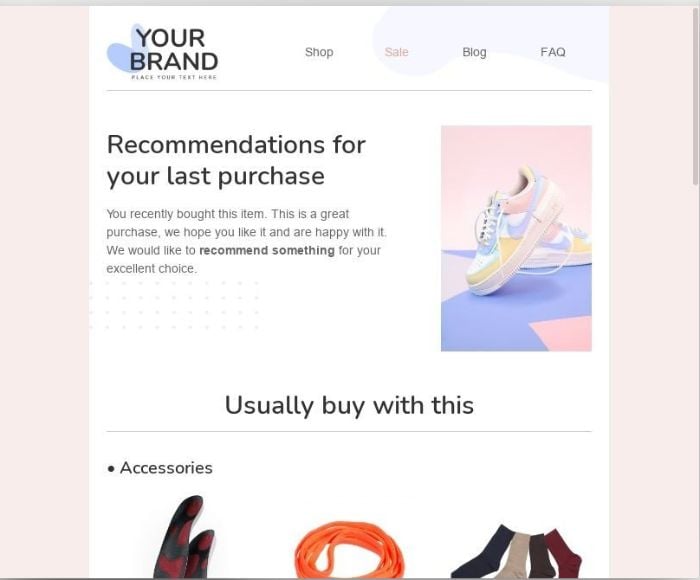
5. Follow-Up Email Template
With a clean, streamlined design, this follow-up email template is ideal for soliciting post-purchase feedback from your customers.
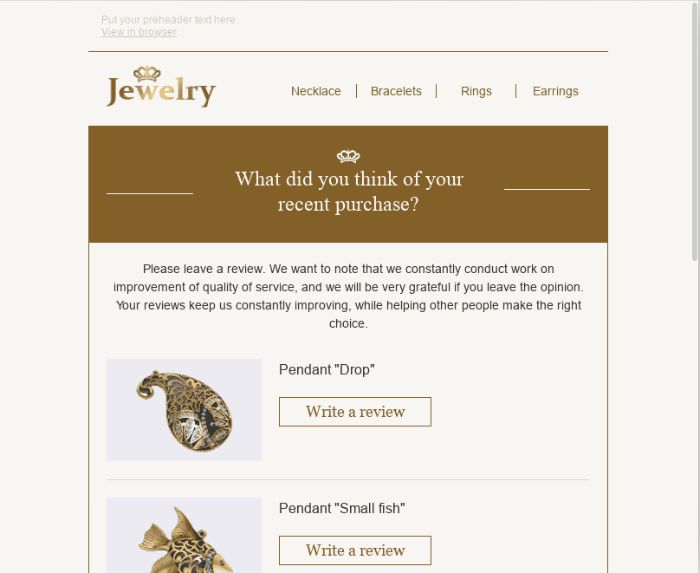
E-Commerce Email Marketing Frequently Asked Questions
How much should I make from e-commerce email marketing?
What you earn from e-commerce email marketing is relative to what you invest. With an average of ROI $36 earned for every $1 spent, you’re likely to earn more from e-commerce email marketing than most (if not all) other marketing channels.
How does e-commerce use email marketing?
E-commerce relies heavily on email marketing as a way to connect with both current and prospective customers. It’s used as a way to promote new products, communicate exclusive offers and deals, and engage with the target audience.
How do I start e-commerce email marketing?
To start e-commerce email marketing, all you need is an email marketing software, some e-commerce email templates, and one or two fully fleshed-out campaigns. The rest will fall into place as you grow your subscriber list.
How important is email marketing for e-commerce companies?
Email marketing is a critical part of any effective e-commerce marketing strategy. Without email marketing, you could be leaving tens or even hundreds of thousands of dollars on the table.
Conclusion: E-Commerce Email Marketing
Whether you’re a new or seasoned e-commerce business owner, email marketing should have a large part to play in your overall marketing strategy.
It’s not difficult to get started, and once you do you now have the best strategies in hand to make your campaigns a success.
To recap, the 10 strategies you should implement in your e-commerce email marketing strategy are:
- Start with a welcome series.
- Be sure to include a clear call to action.
- Use personalization to segment your list.
- Automate what you can.
- Create a dynamic cart abandonment series.
- Perform split testing.
- Use email to encourage engagement.
- Offer exclusive experiences and rewards to loyal subscribers.
- Set up back in stock or waitlist emails.
- Utilize dynamic content.
With these strategies in place, you’ll know that you’re doing everything you can for boosting engagement and conversions.
Which of the above strategies are you most excited to implement in your email marketing strategy?

